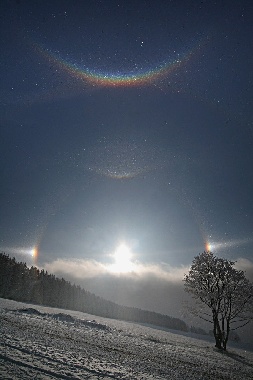On 29 December 2007, Radomir Vondra observed a complex diamond dust display above an inversion cloud layer. He was walking to the ski slope in the village of Dolni Morava, when he saw the halos between 12:30 and 13:00. The elevation of the Sun was about 15 degrees above the horizon, and the dominant phenomena that first appeared were the parhelia and a bright circumzenith arc. Later, after the sky got clearer, a suncave Parry arc appeared above the upper tangent arc. An unsharp masked version of the photo is also available ( 1 ).
On the same day, Matej Lebl observed well-defined parhelia in Rokytnice nad Jizerou ( 2 – 3 ).
Text: Martin Popek, Lukas Shrbeny

Possibly the 22 halo here is mostly Lowitz arcs.
ReplyDeleteYou're right I can see on the left upper and circular lowitz arcs quite well. In 2004 I got a display that showed very well defined lowitz arcs inluding long circular lowitz arc.
ReplyDeleteThis strikes me as a display where supercooled water cloud layer has locally turned into crystals because of the nuclei provided by snow guns. The transformation has stopped to the dark water cloud layer in the horizon, typical sight in the dust display in High Arctic and Antractic.
ReplyDeleteThe description of the sky clearing up fits this scenario: clearing takes place as the crystals:water droplets ratio increases. The dark water cloud layer does not seem to be covering the distant trees, probably the cloud layer is above the observer. So it seem to me this display is not above the clouds. It has formed from the clouds and the crystals then precipitate to the ground.
I have noticed this water cloud border in many display photos of the central Europe mountains. It seems that cloud transfomation is better for creating major displays than crystals growing in clear skies. The latter is always the case in Finnish dusts.